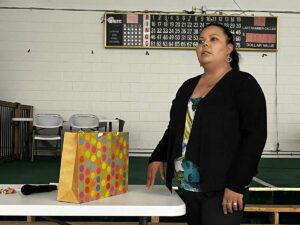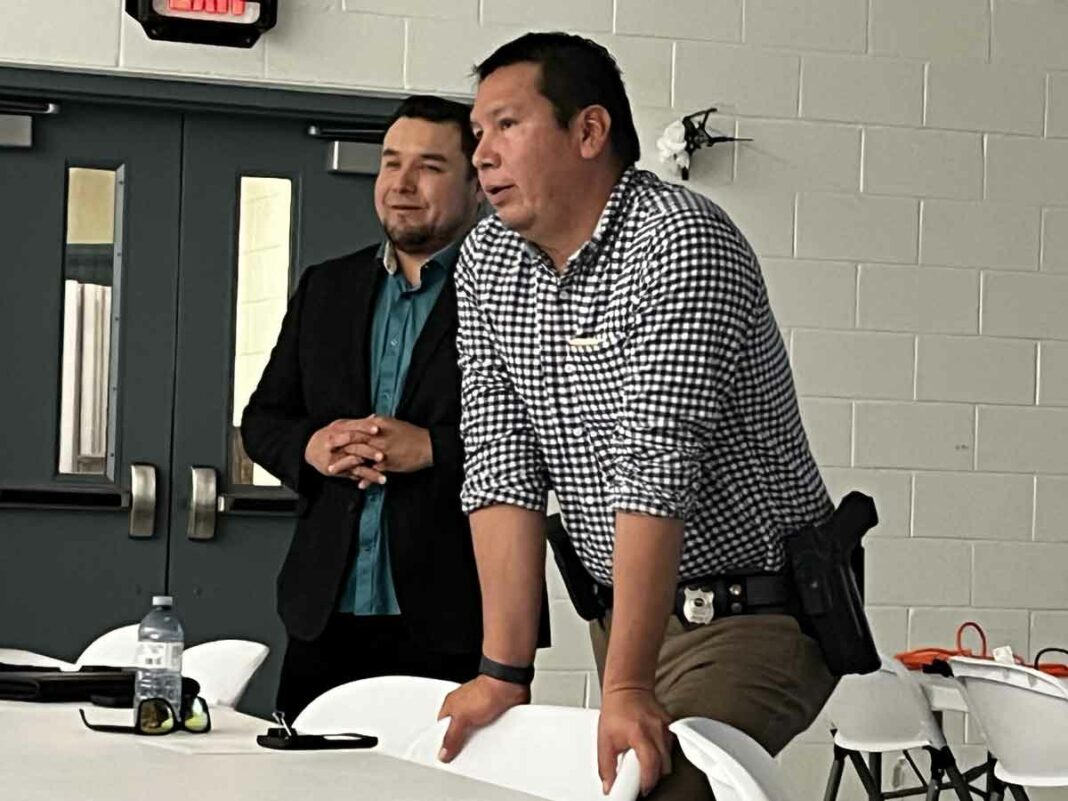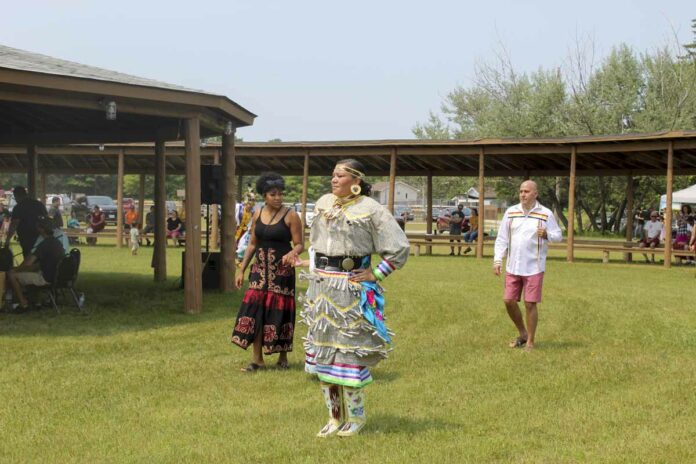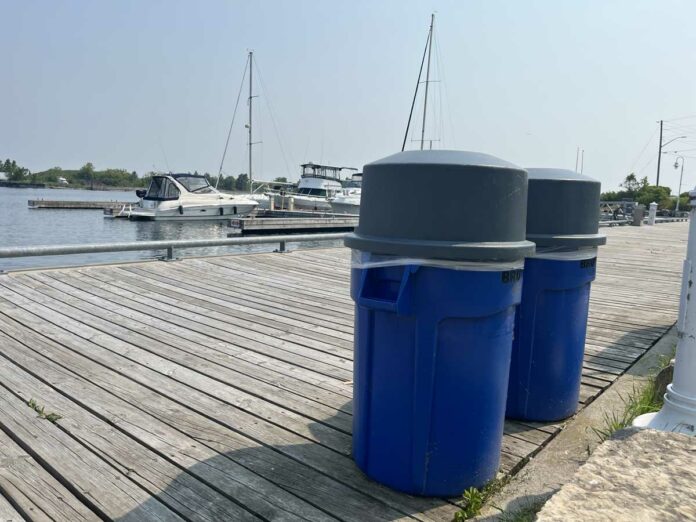M’CHIGEENG—Everyone should know what human trafficking is, know the signs and how to support survivors. Everyone should know that it happens here, on Manitoulin Island. A conference held June 13 and 14 in M’Chigeeng First Nation aimed to address the knowledge gap on human trafficking.
Valisa Peltier, shelter coordinator under M’Chigeeng’s mental health and addictions department, organized the conference. She was tasked with bringing human trafficking training, awareness and education to the community and started by looking at what local supports and services were out there and opted to host a conference. “What’s better than a conference to have that more personal experience of listening to people talk about their own lived experience and talk about the programs and services?”
According to Public Safety Canada, human trafficking involves “recruiting, moving or holding victims to exploit them for profit, usually for sexual reasons or forced labour. Traffickers can control and pressure victims by force or through threats, including mental and emotional abuse and manipulation.”
Human trafficking doesn’t necessarily involve crossing borders, and it is happening in communities across the country, including communities across Manitoulin.
Ms. Peltier attended a conference in March at Wiikwemkoong where she met Jessica Desmond, a ‘survivor turned crusader’ and one of the survivors who shared their stories recently in M’Chigeeng. The first day of the two-day Defeating Human Trafficking conference was geared towards “that lived experience: the stories that would impact the community more than just hearing from an officer,” said Ms. Peltier.
Michelle Mainville, a survivor of human trafficking from the ages of 12 to 21 years, shared her story and survivor Bridget Perrier also spoke of her lived experience. Ms. Perrier has cofounded Sextrade 101, a survivor-led organization that educates the public about ‘the real truths’ of prostitution and human trafficking.
“I think a lot of people were shocked (by the survivor stories),” Ms. Peltier told The Expositor. “I hope a lot of people had their eyes and their minds opened to the stories.”
Something that really impacted Ms. Peltier was that for many survivors, “All of the signs were there but people did not tune in,” said Ms. Peltier. “They didn’t think or know how to acknowledge it, or they didn’t even know those were signs.”

There are signs that family and friends can watch for: changes in behaviour, lifestyle, friends, social media use, daily routines and changes in attendance and grades at school. “Behavioural indicators what people are already doing that may give us some idea that they are being trafficked or being lured,” said Detective Sergeant Todd Fox of UCCM Anishinaabe Police Service on the second day.
Physical signs may be present also, said Rachel Webster, crime and intelligence analyst with UCCM Police. These could include unexplained bruises, cigarette burns, or a new name or symbol tattoo (branding). Victims may be in possession of large amounts of cash, prepaid credit cards, hotel receipts or keys and may not be in possession of their identification.
Traffickers look for young people to connect with and will form relationships with their targets. They use false promises of a better life and relationship manipulation to ensure compliance. There could be threats against family or pets, intimidation, physical violence, isolation, or financial manipulation.
“A lot of victims involved make a lot of money but it’s rare that they see any of that,” said Detective Constable Ed Simon, also with UCCM Police. Traffickers will also go as far as impregnating the victim to create a familial bond. “They will treat (the victim) as a girlfriend and actually have children as another form of control, or will put the victims in debt so they’re financially dependent.”
Anyone is at risk, but some factors make people more vulnerable. Youth between the ages of 12 and 25 years are more vulnerable, as are people with a history of experienced violence, child abuse or sexual abuse; a low level of education; or a low level of self-esteem. People who are precariously housed or homeless, have spent time in the child welfare system, experience mental health and developmental disabilities and addiction are also at higher risk. Targets often lack family support and are isolated. Indigenous women and girls and LBGTQ2s+ are especially vulnerable.
“Most victims are known to their traffickers,” said Detective Constable Simon. “And 51 percent of women being trafficked are Indigenous, which is alarming given we only make up two percent of the Canadian population.”
Human trafficking is the second most prolific criminal market in Canada and is increasingly related to organized crime. “There’s more money in human trafficking,” noted Detective Sergeant Fox. “There’s less chance of getting caught. Possession of drugs is possession of drugs. If someone is caught with a female who doesn’t say anything, the trafficker gets off scot-free. The risk is lower.”
What does human trafficking look like on Manitoulin Island? UCCM Police have had five reported cases of suspected human trafficking over the past five years. They were reported by concerned family members. Police made contact with the potential victims, but no human trafficking charges have been laid.
Often, the survivor doesn’t want to be involved in the system out of fear, and many people don’t realize there’s a crime being committed when they are involved in the situation.
In her work, Ms. Peltier has seen individuals showing signs of being victims of human trafficking. “What we’re noticing here in our community is it’s more personal,” Ms. Peltier said. “It’s the boyfriend, the girlfriend selling their loved ones at parties for drugs to the drug dealers.”
Her goal was to bring that awareness to the community. “It’s not just getting picked up and taken out of the community,” she said. “It’s their boyfriends, their spouses.”
This makes it hard to get people out of a human trafficking situation because the traffickers are their loved ones, and it’s hard for these individuals to stay away from those situations, said Ms. Peltier. “It’s such a close community. Everybody knows everybody. Everybody is family to somebody. Everybody’s triggers are all over.”
When her organization sees the signs, they will pull the individual in to talk with them. “We have that honest conversation with them but at the end of the day, it comes from them. If they don’t want to speak up, if they don’t want to tell us the truth and the facts, then we can’t help,” Ms. Peltier said.
It’s all about building rapport and trust and it can take multiple conversations to get there. “Hopefully we will get them to that point someday. It’s just not giving up on them and being with them and talking with them to get them to open up.”
“Maybe you can be that concerned friend or family member. Maybe you can make that report so police can look into whether it’s human trafficking or not,” said Detective Sergeant Fox.
It’s a topic that needs to be talked about and not just within the community, Ms. Peltier said. “It needs to be talked about at the dinner table. It has to be talked about at family reunions. It’s a topic that everyone needs to talk about.”





